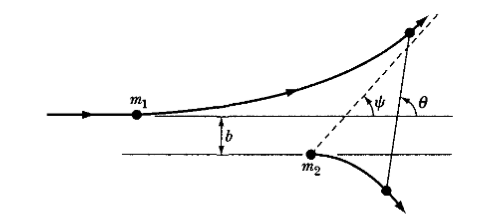Scattering Cross Sections
 In the above diagram, we have 2 particles, m1 and m2 with a repulsive force acting between them.
In the above diagram, we have 2 particles, m1 and m2 with a repulsive force acting between them.
- The impact parameter, represents the distance between m1 and m2 if there were no force. The impact parameter is related to the angular momentum, mass and potential energy in the following equation
This can be rewritten into the following with the equation for initial kinetic energy:
- In some cases, we cannot take a measurement of . This is often the case in nuclear or atomic physics.
- In these cases, we introduce the concept of a differential scattering cross section, denoted by
- This is the measure of the number of interactions on the impacted particle that lead to scattering into the solid angle at the angle , over the number of particles incident per unit area. For example, if you have particles scattered into per unit time, then the probability is given by
Where I is the intensity of incoming particles
The relation between the impact parameter and scattering angle () is given by the following equation
Central Force Problems
 For rotational symmetry about the direction of motion of the incoming beam of particles we can define a ring around the approaching beam of thickness like in the above figure. We can also set the angles and in the diagram below equal to each other, and , the scattering angle.
For rotational symmetry about the direction of motion of the incoming beam of particles we can define a ring around the approaching beam of thickness like in the above figure. We can also set the angles and in the diagram below equal to each other, and , the scattering angle.

Therefore, , and the scattering angle is given by the following integral
using the modified initial kinetic energy equation from above,
We can use this axial symmetry of the beam to Total potential energy
The first term is the potential from external forces, the second term is known as interaction potential.
2 particle collision
Recall there is Elastic collisions and Inelastic collisions
Consider a collisions in the lab frame:
Where is post collision velocity
Similarly:
Same collision viewed from thze center of mass frame
Since center of mass frame and center of mass at rest in the center of mass at rest in the center of mass frame are the same
Vectors are anti-parallel, means the two particles approach head on in the center of mass frame.
figure 1 here
Scattering angle is the same, not generally true in the lab frame.
Consider now kinetic energy in the center of mass frame:
This can be rewritten as
or
\frac{1}{2}\left( m_{1}+\frac{m_{1}^{2}}{m_{2}} \right) \vec{v}_{1}^{*^{2}} = \frac{1}{2} \left( m_{1} + \frac{m_{1}^{2}}{m_{2}} \right)\vec{v}_{1}' ^{*^{2}}Since elastic
Meaning
and
Laboratory system:
insert figure 2 here
m2 is at rest
Center of mass system:
figure 3 here
Trajectories in lab frame
Seperating in 2d X component
Y component
- This is because the momentum upwards is the same as the momentum downwards
Trajectories in COM frame
figure 4
Relationship between in lab frame with angle in lab frame
Break eq. 3 into components x:
y:
is only in the x direction
Testing this for edge cases
Similar correct method for product 2